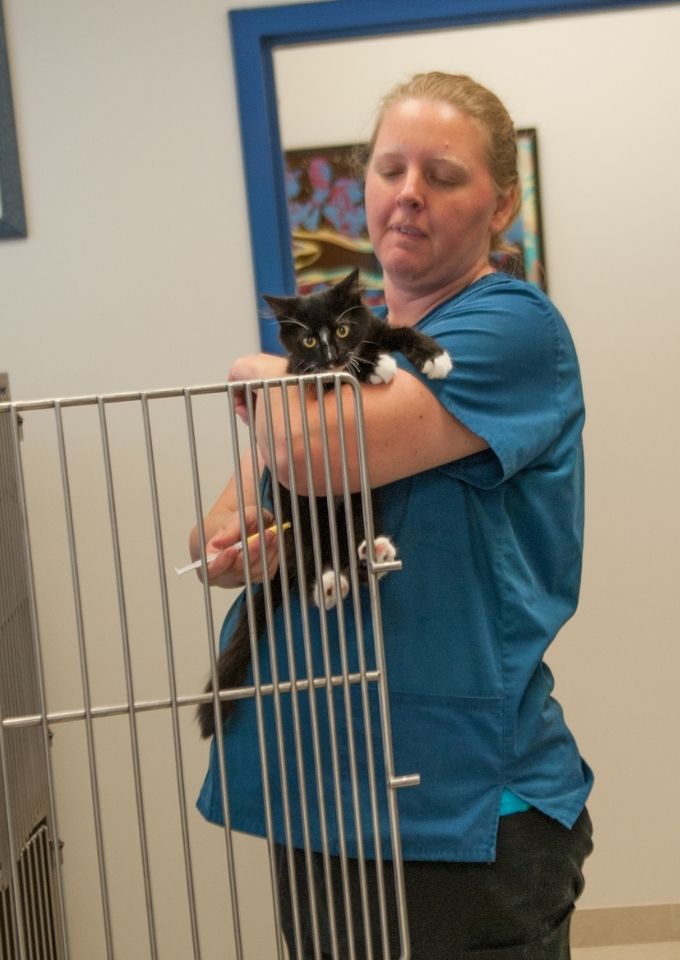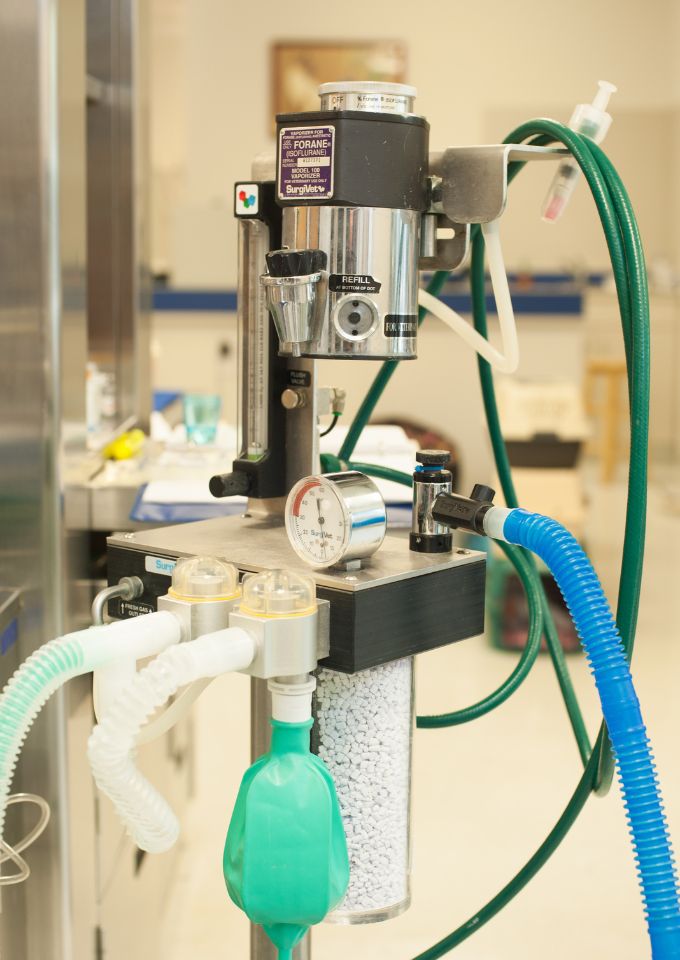The Sound Cat Veterinary Hospital
Feline Diabetes Mellitus

Veterinary Services
Feline Diabetes Mellitus
Your cat has been diagnosed with Diabetes Mellitus. Diabetes occurs in cats when there is decreased or no production of insulin by the pancreas. Predisposing causes of this disease include obesity, pancreatic injury or disease, and the use of certain pharmaceuticals. Insulin is critical to the body to allow the cell to use sugar (glucose) for energy. Diabetic cats have excess glucose in the blood that cannot be used by the body causing the body to be starved for sugar. Because there is so much unusable sugar in the blood, some escapes through the kidneys which are not able to handle such high sugar levels. Some of the body’s water is also lost along with this sugar.
Clinical signs of diabetes may include: excessive thirst, excessive appetite, increased dilute urine output, weight loss, and abnormal posture (“down in the hocks” stance). Because there is sugar in the urine of diabetic cats, bacteria love to live there. Many diabetic cats will also have a urinary tract infection. If diabetes goes untreated, an emergency situation can develop called ketoacidosis. This occurs when the body has starved too long and begins breaking fat into simple energy particles, which contribute to a metabolic acid/base imbalance. The cat will become too weak to eat or drink and can develop life-threatening dehydration. This condition can usually be avoided with careful treatment and regulation of diabetes.
The main treatment for diabetes is insulin injections. Many cats will need an injection twice daily but some can be regulated with a once-daily injection. Many different types of insulin exist and not every cat can be regulated with the same type of insulin. Some cats can be regulated well with human insulin, called Humulin, which comes in different formulas to last different lengths of time. The longest-acting human insulin is called Humulin U which lasts 6-12 hours with peak activity 3-6 hours after injection in cats. Some cats can be regulated on this type of insulin twice daily. Because this insulin was created for humans the structure of the insulin particle is slightly different than the cat insulin particle. Some cats will form antibodies to this insulin rendering it completely inactive. Most cats do best with a type of insulin called PZI which is very long-acting. In most cats, it lasts 12-24 hours with peak activity 6-12 hours after injection, so some cats will need it once daily and some twice daily.
In some cats, an anti-diabetic drug called Glipizide can help control diabetes. It is very rare that this drug can be used as the only treatment but in some cases, it can aid in regulation in addition to insulin.
Diet, exercise, and body fat are considered important to the control of diabetes. There are two theories on what the perfect diabetic food should consist of. One theory states that a high fiber diet will aid in diabetic control by allowing a slow steady release of glucose from the intestines to the blood. The other states that a diet high in protein will decrease the dependence on dietary carbohydrates and that protein will be relied upon for energy. Both types of diets have helped in the control of diabetes in both humans and cats.
Obese cats with diabetes will be easier regulated and may have a less severe form of diabetes if they get down to a healthy weight. Since it is important for diabetics to eat in order to utilize their insulin, a good way to help an obese diabetic cat lose weight is through a moderate increase in exercise instead of a strict diet. Exercise will also help glucose get into cells.
ALWAYS HAVE FRESH WATER AVAILABLE
The goal for the treatment of a diabetic cat is not to have perfectly normal blood glucose at all times but to have an acceptable blood glucose level at almost all times. It is important for a cat to have enough insulin in their body for most of the day to be able to use food for energy and maintain a healthy weight and most importantly; avoid ketoacidosis.
In a 24-hour period, it is considered very good if a cat can maintain a blood glucose level between 100 and 300. This is often not possible. Some cats will have a higher blood glucose level at the time they are due for their next injection. High blood glucose for a short period of time is not dangerous, however, blood glucose that is too low can be very dangerous. It is very important not to give too much insulin.
In order to determine the correct insulin dose for a cat and keep them well regulated, frequent testing of the blood glucose level is required. This testing can be done in the hospital initially with a blood glucose curve. This consists of blood glucose checks throughout the day after the administration of insulin. It allows the veterinarian to monitor your cat’s response to insulin and determine how many hours after insulin administration, the lowest blood glucose will occur (also called the nadir). Once this is known, the effect of insulin doses can be monitored by “spot checks”, or one blood glucose measurement at the cat’s nadir.
Sometimes another test is performed to determine the cat’s average blood glucose over several weeks which helps assess overall regulation.
As a cat is being regulated it is not uncommon to need insulin dose changes or even a change in the type of insulin. Many cats will need more or less insulin as their weight changes, or the severity of their diabetes changes. In rare instances, a few cats will eventually not need insulin anymore. Illness of any type can interfere with diabetic regulation as well.
Because regulation of a diabetic cat can involve many trips to the hospital, some owners of diabetic cats will learn how to test blood glucose levels at home. This involves the purchase of a glucometer and test strips from a drugstore. This is an inexpensive device, which requires only a small drop of blood for measurement. A small needle is used to prick a vein on the cat’s ear to get the drop of blood. Most cats are well behaved for this procedure. If you have an interest in learning how to do this at home we would be happy to teach you. It is important that you keep a journal of insulin doses and blood glucose levels and carefully record the time of day.
For the first few weeks of regulation at home, it is a good idea to speak with a doctor or technician daily to answer your questions about regulation and help you adjust the dose of insulin.
Insulin must be stored in a refrigerator. It is normal for some particles to settle to the bottom of the bottle. It is important to have the insulin well mixed before drawing it up into the syringe. Insulin particles are very delicate so it is important not to shake the bottle but to gently roll it instead. You will need a prescription for insulin syringes. They come in a box of 100. You may use a new syringe each time, but it is considered ok to use each syringe a few times before disposing of it. You will be instructed on how to give insulin properly.
If you get into a struggle giving the insulin and you are not sure if the cat got it all, do not try to give more. You may risk a low blood glucose crisis. Wait until the next scheduled insulin dose. If the cat is not eating for any reason hold the insulin and call your veterinarian. If you know that the cat will not be able to eat because of travel or surgery or any other reason hold the insulin dose. If you miss a scheduled dose by more than an hour do not try to give it, just skip it and wait for the next scheduled dose is important to be able to recognize a low blood glucose crisis. Signs include lethargy, listlessness, grogginess or a drunken appearance. Do not give insulin if this occurs. Offer food right away. If your cat will not eat, have some Karo syrup handy to smear in his/her mouth. A very low glucose level can lead to seizures. Contact your veterinarian right away. He/she will need to determine what the cause of the low glucose was.

